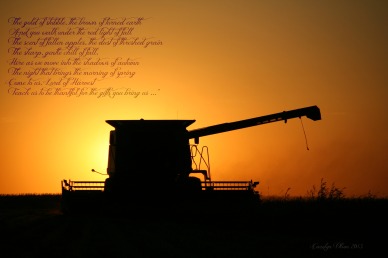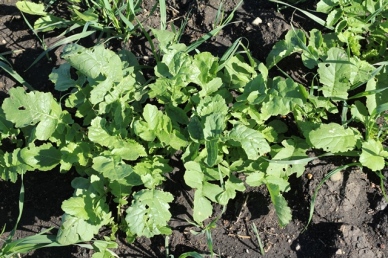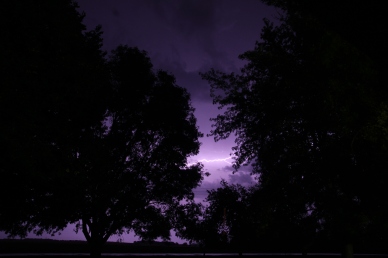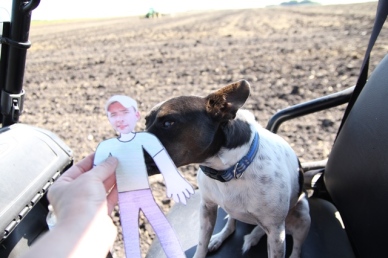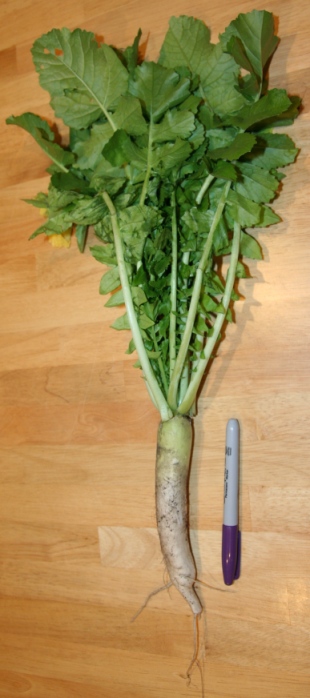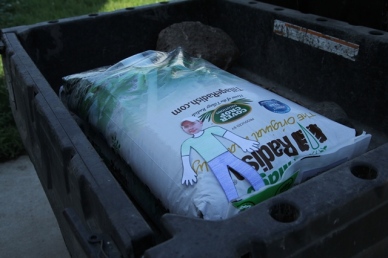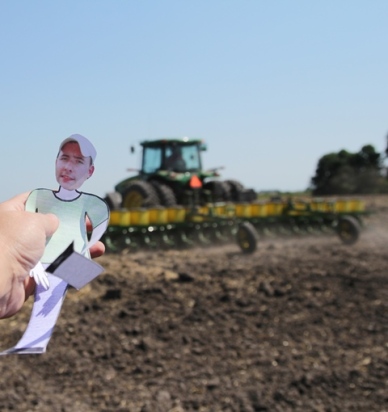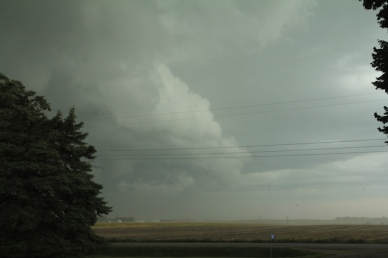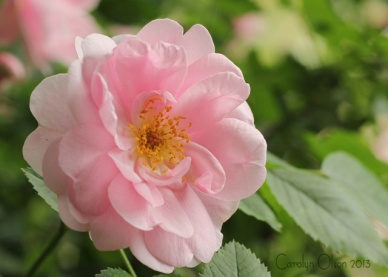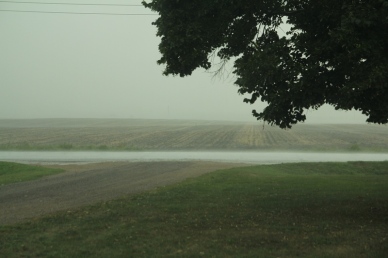Top 10 lists are fun write out. I thought it would be fun to put photos with my top 10 list of things I love about farm life.
10. Fresh pork. We are pig farmers, so we always have a freezer full of fresh pork. Bacon and pork chops have to be the favorites. Grilled pork chops and Marshall Salad pair very well together. Follow the link for the salad recipe, shown here with Beef Strip Steaks to show a little love to our beef friends.

9. Spring. After long winters of snow, ice, and wind, it is so good to be able to work outside in just a long sleeved shirt. The smell of freshly turned soil is so awesome. After the crops are planted, waiting for the first shoots to push through the ground seems to take forever. Suddenly, there is a green haze over the fields. We wait eagerly for the first signs that you can “row” a crop.

8. Watching crops grow. Growing our crops is our business, but that doesn’t mean we’re on autopilot like some robotic device. I worry. A lot. I worry about getting enough rain, too much rain, hail storms, wind storms. In the fall, I worry about early snow storms. There are things we can do to give our crops the best chance at reaching their full potential: testing the soil and the manure to make sure we are applying the correct amount of manure in the fall, using cover crops to hold top soil in place over the winter, waiting to plant until the soil temperatures are ideal in the spring, and timing our weed control methods to have the least impact on the plants (check out this flame weeding video for one of our methods). The rest I shouldn’t worry about, but I’ll admit, I have troubles giving all of that to God.
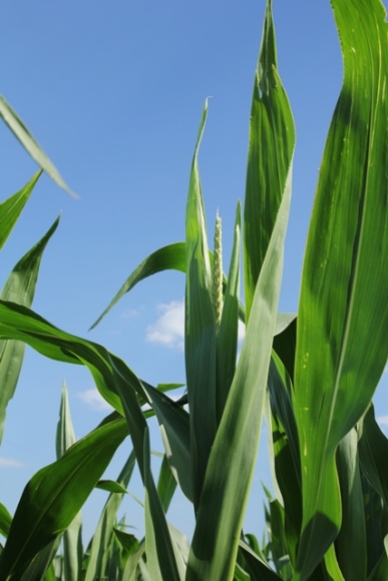
7. Meeting cool people. Jonathan and I have had the privilege of meeting some pretty cool people because we sell some of our corn to a place that makes vodka. Dean Phillips, of Phillips Distilling has visited our farm, and learned about the combine, and what it takes to grow the corn they use. Joe and Connie from Chatham Imports have also visited our farm, learning about us and what it is we do. You can read about that in this series -The Power of Bundt Cake Part 1, Part 2, Part 3, and Part 4. There have also been a few advertising agencies that we have met. Jonathan was even interviewed for the Prairie Vodka website. That was a pretty cool experience.

6. Work hard, play hard. We love getting together with family. If it is at a lake, all the better. I like to relax a bit and fish, but Jonathan loves to play on the jet skis. We look forward to the few days in the summer where we are free to leave the farm and relax.
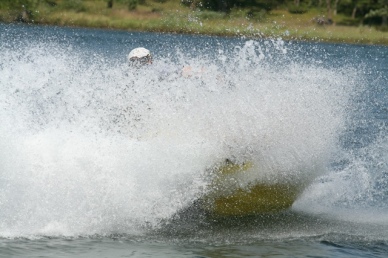
5. Wildlife. Who doesn’t like to watch wild animals in their habitat? This year, I have watched a fox and her two kits near our grove of trees, a doe and her fawn grazing in our yard, and a coyote who casually walked away while I was working in a field near it’s home. I have watched a dozen hawks circle in the sky while preparing soil for planting, I watched a cicada drying its wings after its metamorphosis, and have seen butterflies softly flitting around in the yard. Watching the wildlife makes me appreciate the beauty all around us.
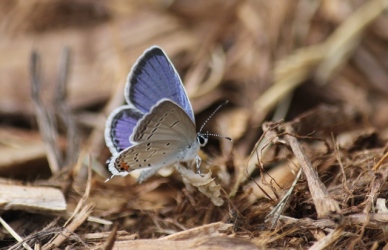
4. Sunsets. Living on the prairie has its advantages. The skies are endless, and most nights we are treated to wonderful sunsets. In the summer, the sunsets seem to go on forever. To see some gorgeous North Dakota sunsets, visit my friend, Katie Pinke’s blog. She has a blog post about 14 Late Summer North Dakota Sunrises and Sunsets. One thing I love about working outside in the evening, is the way the skies can change so quickly. From a flaming red and orange, to a soft pastel pink, to a mix of purple and deep pinks all a matter of minutes.
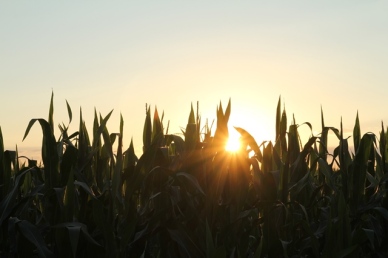
3. Driving large pieces of machinery. I was not meant to drive a little car like a Toyota or a Honda. I like to drive tractors and combines. You can see more when you are sitting up high. Maybe that’s why I like driving pickups more than cars. I do love my minivan, but I get a little embarrassed when we bring it in for an oil change and there are corn stalks stuck on the bottom from driving out to the combine. I was pretty nervous to learn how to drive the combine, but now I love it! We had our combine all set up for our Century Farm Celebration and our county’s I Met a Farmer Tour. It’s a fun way to introduce people to farming, and they think it’s cool that I get to drive it.
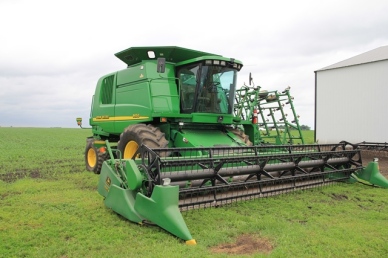
2. Harvest! I love harvest. This is the time of year when we see the results of all the labor that was put into the crop throughout the growing season. When we plant the seeds in the spring, we are hopeful that we will have favorable weather, few bad storms, and be able to harvest enough so we will be able to farm again next year. We are thankful for every bushel of grain that goes into the bin. Yes, the hours are long, the pace is frantic at times, and there is always the worry of an early snowstorm, but those are the things that keep it from being boring. This is one of my favorite harvest photos, paired with a harvest prayer. It was also shared as a Wordless Wednesday photo a few weeks ago.
So, what is the number 1 thing I love about farm life?
1. Working every day with my best friend, Jonathan. Yeah, yeah. It’s sappy, I know. But I wouldn’t trade this life with anyone. Jonathan and I celebrated our 25th Wedding Anniversary in August. We were married during a drought year, so we came home from our honeymoon a day early to help with corn harvest. This city girl learned quickly how to move wagons, and unload the corn into the bins. Jonathan and his dad are very patient teachers, which made the transition so much better. I later graduated to running the stalk chopper, then the chisel plow, the field cultivator, and finally the combine. With every new skill, Jonathan has been able to calm my nerves, and give me confidence to tackle the next big thing. I have grown from a shy 20 year old newlywed into a mouthy 40 (something) gray haired lady. I don’t think he regrets that. I don’t care what you want to do in life, a supportive family makes it much easier. To Jonathan, thank you for being a great man of God, husband, teacher, jokester, and friend. I love you!

